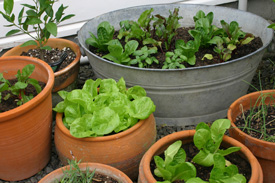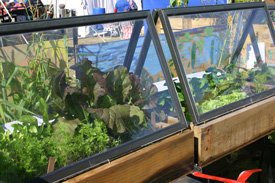Grow crops in pots
No Dirt to Dig
Who doesn’t love the idea of eating fresh homegrown fruit and vegetables every day? Anyone can make it happen, even when there’s no dirt to dig. If your outdoors is tiny or temporary (or if the prospect of digging is putting you off getting started) growing crops in pots is the way to go.
When it’s cold and wet out there it’s convenient to have veges growing a few steps from the kitchen. The plants are happy too – they grow faster in sun-warmed, well-drained container mix than they do in cold soggy ground. In a sunny sheltered location close to the house, they’ll suffer less from wind and frost, and absorb any extra warmth radiated by concrete paving. What’s more, container gardens close by the living area are less likely to be forgotten and feeding and watering fits easily into the household routine. Weeds, slugs and snails are less of a problem. For extra warmth over winter and early spring, try a cloche or make a cold frame out of an old window.
Any containers will do, provided they have holes for drainage and enough space for the roots and their growing medium (the all important holder of water and nutrients). Garden centres offer an excellent range of containers, including attractive UV-resistant plastic pots and grow bags. Simple raised beds come in easy to assemble kitset options, which are fully transportable.
Resourceful gardeners grow edibles in all manner of found objects, including old furniture, baths and basins, derelict wheelbarrows, plastic fish bins (with holes drilled for drainage), recycled stock feed sacks with their tops rolled down (the woven polypropylene allows excellent drainage). Wine barrels make fantastic vege gardens, and are as decorative as they are practical. Vegetables and fruiting plants need plenty of sun. Place your containers in a sunny sheltered place.
If you’re new to gardening, it makes sense to start small. In just a few wine barrels or a metre by metre box you can grow enough greens to feed a family.
Container crops to grow all year
Loose leaf lettuces are ideal for all kinds of containers. For pots choose small varieties like ‘Tom Thumb’ and ‘Little Gem’. Pick the outside leaves as you need them, allowing the plant to carry on growing. For the sweetest taste, keep up with watering and feeding.
Microgreens are leaves eaten at the tiny seedling stage, two leaves on further from a sprout, just a week or two after germination. At this early stage of growth they contain high concentrations of nutrients and flavour. The leaves of almost any herb or vege plant can be eaten as a microgreen, including fennel, spinach, celery, carrot, peas, beetroot, nasturtium, carrots and radishes. All are easily grown from seed in bowls or trays. Sow a whole tray of one variety or a mixture of different varieties. Look for premixed seeds or mix your own.
Herbs that thrive in dry Mediterranean climates, such as thyme, oregano and sage will also thrive in pots. All the different mints are also great in pots and will grow in semi-shade. Parsley and chives also grow well in pots over winter. Coriander is a good herb for a frost-free climate. It performs best in cooler weather.
Beetroot can be grown either from seed or seedlings. The young leaves are delicious steamed or raw and are highly nutritious, but don’t pick too many if you want to grow a good crop of roots.
Silverbeet makes a very attractive container plant, especially if you grow the colourful ‘Rainbow’ variety. Harvest the outer leaves and the plant will keep growing new leaves. One plant will fill a 30cm diameter pot or 5L bucket. Or grow two or three plants in a large tub or wine barrel edged with bright green lettuces or pretty viola flowers.
Rocket grows well in cool weather and is easy from seed. Its nutritious green leaves add a spicy tang to a sandwich.
Radicchio is one of the most attractive winter vegetables with colourful red leaves. This tasty crunchy vegetable can be eaten cooked or raw. The Italians eat it grilled with olive oil.
Chinese cabbage is well suited to growing in containers as it is best eaten when young. Sow seed every few weeks for a continuous supply.
Broccoli seems an unlikely container plant, but if you have no garden soil there is no reason why you cannot grow your broccoli in pots. One plant will fill a 5L pot. Look for the sprouting types so you’ll have side shoots to eat after the main head has been picked.
Carrots prevail all year round in a frost-free climate and will survive a light frost. Even when it’s too cold for them to grow, they’ll keep in the soil until you are ready to eat them. Sow seed into weed free container mix at least 30 cm deep. To encourage nice straight carrots, screen large chunks from the potting mix. Water regularly and feed with balanced liquid fertiliser. When the seedlings are 3-5cm tall remove some to leave about 2-3cm between each seedling. As the plants grow, thin them some more and eat the thinnings.
Garlic grows well in pots. Purchase fresh clean (NZ grown) bulbs and separate them into cloves, discarding damaged ones. The fat, outside cloves are best for planting. Plant the cloves with their pointed tip upwards, about 3cm deep and 5 to 10cm apart. Closer spacing results in smaller bulbs, but more of them. Harvest in summer.
Shallots can be grown from seedlings or from cloves planted, like garlic, in autumn or early winter. Plant the cloves, 15-20cm apart so that their tops are just level with the soil surface. The leaves can be used like chives while still green. Harvest in summer, keeping the smallest cloves for replanting.
Spring onions, or ‘bunching onions’ can be purchased as seedlings in punnets almost all year round or you can grow them from seed.
Leeks can be grown from seed or seedlings. Fill the pot to a depth of 20cm of soil, leaving space to add more soil as the leeks grow. To transplant seedlings, make holes with a chopstick, about 6-10cm apart, depending on how fat you want your leeks to grow. Alternatively, sow seed and thin to the desired spacing a week or two after germination. For longer white stems, add more potting mix around the base of the leeks as they grow. Leeks are usually harvested two to three months after transplanting, but they can also be eaten when small, as spring onions.
Peas are best grown from seed sown directly in situ. The seeds germinate best in cool temperatures but sowing is timed to avoid flowering in frosty or hot dry weather. Generally, autumn or winter sowing suits warmer climates while early spring sowing is the norm where winters are frosty. Choose a variety to suit your climate and season, and buy fresh seed to avoid disappointment. To grow peas in a large pot, make a teepee with four or five bamboo stakes tied at the top with string. Use garden twine to form a spiral around the teepee then plant seeds at its base. Peas need lots of nutrients. Add compost and sheep pellets to the potting mix, but avoid direct contact with the seed. Feed with liquid fertiliser as plants grow.
Snow peas will grow just like peas on a teepee in a pot, or try them in a large hanging basket.
Potatoes are easy and rewarding to grow in a bag and can be planted as early as June in a frost-free climate. Find out how at www.gogardening. co.nz [home>how to>edible gardening].
Fruit to plant in pots: Strawberries, raspberries, citrus, Ballerina apples, dwarf peaches, dwarf nectarines, figs, grapes, feijoas, blueberries, cranberries, olives.
Tips
- Vegetables and fruiting plants need plenty of sun. Place your containers in a sunny sheltered place.
- For the best nutrition and flavour pick fresh for each meal.
- The smaller your container, the more you need to feed and water.
12-May-2013

Crops in Pots

Cold frames built from recycled windows featured in Paraparaumu College students' display at the recent Kapiti Coast Sustainable Home and Garden Show.

These lettuces are growing in a hanging Yates Vertical Gardening Bag filled with Tui Vegetable Mix. To plant the seedlings, wrap the leaves in newspaper and poke them through from the inside, adding potting mix as you go. Try a row of these bags for an 'edible wall' effect. Water and feed often.

Lettuces and beetroot thrive in raised planting boxes


